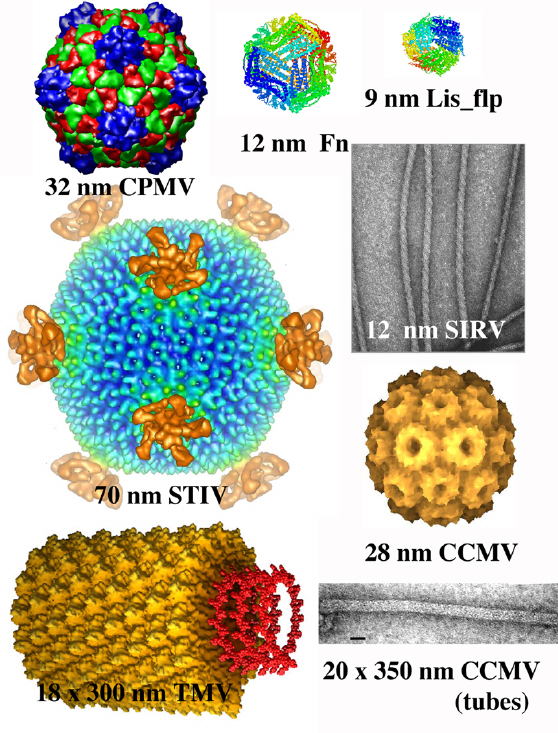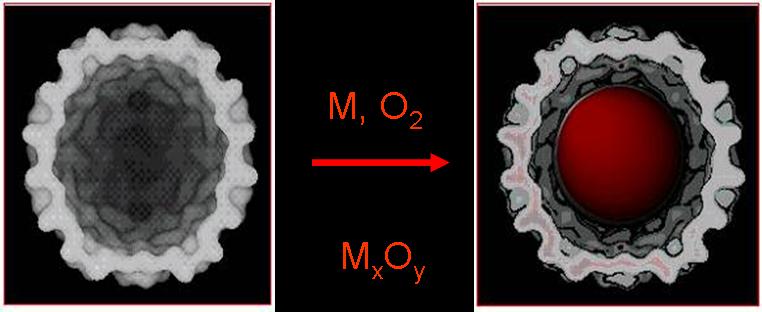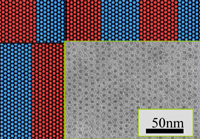Magnetic Nanoparticles
Research: Properties of 0-Dimensional Magnetic Systems
This research is done in conjunction with the Center for Bio-Inspired Nanomaterials (CBIN) at Montana State University (MSU[BROKEN LINK]), which is an interdisciplinary research team spanning several departments including Chemistry, Physics, Plant Sciences, and Engineering. Protein cages are at the heart of all work done in this collaboration. Some cage structures, such as ferritin, Cowpea Chlorotic Mottle Virus (CCMV), and Tobacco Mosaic Virus (TMV) are widely known. However, MSU, with its close proximity to Yellowstone National Park and all its thermal features, is in a unique position to isolate previously unknown protein and virus structures that can withstand gruelling environmental conditions. The heartiness of these new structures, compared to the delicate nature of typical organic materials, makes them very forgiving and versitile materials. The key features that all these cages share are that they are hollow (after RNA/DNA or a native oxide has been removed), porous to ions, and can be functionalized to interact with specific targets. These properties make protein cages very useful toward such goals as catalytically enhanced clean hydrogen production, targeted drug delivery, and magnetic memory. This work is supported by an NSF sponsored Nano-scale Interdisciplinary Research Team (NIRT) and from the Office of Naval Research (ONR).

Images of protein cages of various sizes.
Through genetic manipulations and creative chemistry, the interiors of these cages can be filled with pure metal and metal oxide particles. The cages serve to constrain the size and shape of such particles in addition to providing an organic shell between neighboring particles to mute magnetic interactions. Such spherical particles, in the 5 - 30 nm diameter range, will exist as a single magnetic domain and will exhibit superparamagnetic behavior. Such systems exhibit properties very different from their bulk counterparts.

Mineralization of transition metal oxides inside protein cages.

Self arranged array of protein cages
An analog for our work can be drawn to the early work done on thin films where new properties emerged as the film thickness was reduced, the perpendicular degree of freedom was quenched, and surface effects became significant. We now move from these 2-dimensional systems to 0-dimensional systems in which around 50% of the unit cells are on the surface. Our aim is to discover what new emergent properties arise in these circumstances and what the mechanisms involved are. The specific properties we have been investigating are surface vs. bulk magneto-crystalline anisotropy, the temperature and field dependence of the particle moment, changes to electronic structure, and the contribution of the orbital magnetic moment.
The experimental techniques we employ include transmission electron microscopy (TEM), electron diffraction (ED), x-ray diffraction (XRD), x-ray absorption spectroscopy (XAS), x-ray magnetic circular dichroism (XMCD), x-ray absorption fine structure (XAFS), magnetic susceptibility (ACMS), vibrating sample magnetometry (VSM), and electron magnetic resonance (EMR). The diffraction and magnetometry work is conducted here at MSU while the x-ray studies are performed at the National Synchrotron Light Source (Brookhaven National Lab) and the Advanced Light Source (Lawrence Berkeley National Lab).

